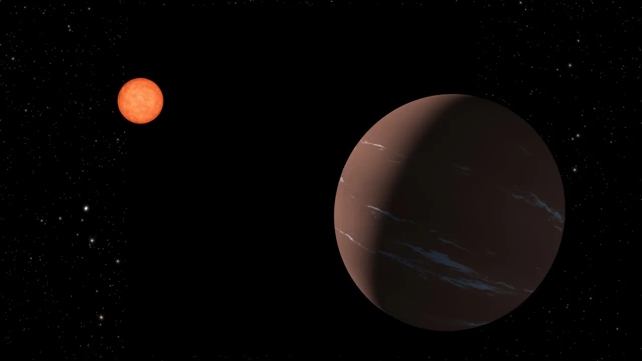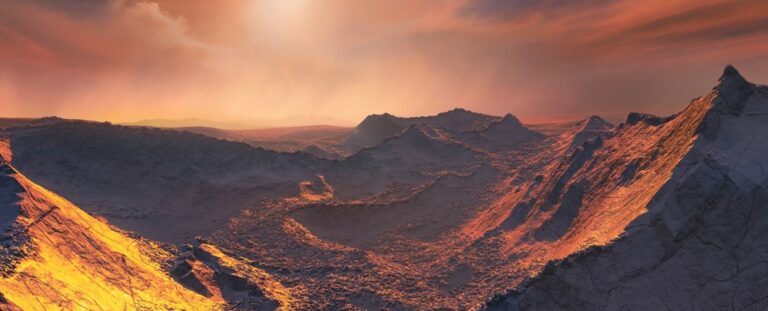Astronomers Discover Potential Habitable Super-Earth
Astronomers have recently made an exciting discovery of a Super-Earth orbiting a red dwarf star located approximately 137 light-years away. This newly found planet, named TOI-715b, has a radius about 1.55 times that of Earth and is situated within the habitable zone of the star. Additionally, there is another potential planet in the same system, which is similar in size to Earth. If confirmed, this would be the smallest habitable zone planet ever detected by the TESS mission.
The star, TOI-715, is classified as an average red dwarf and is approximately one-quarter the mass and radius of our Sun. TOI-715b orbits in close proximity to the star, completing one revolution around it in just 19 days. Due to the dimness of red dwarfs compared to the Sun, this places the Super-Earth within the star’s conservative habitable zone.
The discovery of TOI-715b and its companion planet has been detailed in a research paper titled “A 1.55 Earth-radius habitable-zone planet hosted by TOI-715, an M4 star near the ecliptic South Pole,” published in the Monthly Notices of the Royal Astronomical Society. The lead author of this study is Georgina Dransfield, affiliated with the School of Physics & Astronomy at the University of Birmingham.

The concept of a conservative habitable zone (CHZ) provides a more useful framework. This concept was introduced in a 2014 paper by Kopparapu et al. It defines a region around a star where a rocky planet receives solar insolation between 0.42 and 0.842 times that of Earth. Any rocky planet within this range is considered to be in the CHZ, regardless of its distance from the star.
The detection of a Super-Earth within a star’s CHZ is always a thrilling discovery. It ignites our curiosity about other planets and the potential for them to support life. This makes them more captivating than planets like Hot Jupiters, which have no possibility of hosting liquid water or sustaining life. Even the most resilient extremophiles would not survive in the harsh environment of a Hot Jupiter.
However, this discovery is also significant for a couple of other reasons.
“At long last, the era of JWST has arrived, and with it, the age of detailed exoplanetary atmospheric characterization.” – From “A 1.55 Earth-radius habitable-zone planet hosted by TOI-715, an M4 star near the ecliptic South
Pole.”After the discovery of numerous exoplanets, astronomers have begun to observe patterns in their population. One notable trend is the existence of a gap in the population of small planets, specifically those with radii between 1.5 and 2 times that of Earth. This gap is commonly referred to as the small planet radius gap or the sub-Neptune radius gap, and it is also known as the Fulton gap and the photoevaporation valley. Interestingly, a planet named TOI-715b with a radius of 1.55 times that of Earth falls within this gap.
It is highly unlikely that no planets form within this radius gap. Instead, it is believed that planets initially start out larger and gradually lose mass, eventually ending up within the gap. Therefore, the Fulton Gap provides valuable insights into the mass loss process experienced by certain planets.
Astronomers hypothesize that planets within the gap begin their formation as larger bodies, but their stars gradually strip away some of their mass through a phenomenon known as photoevaporation, causing them to shrink. This is why the gap is sometimes referred to as the photoevaporation valley. However, there is still a significant amount of uncertainty surrounding this valley and the process of photoevaporation. As a result, astronomers are eager to study planets within the gap in order to gain a deeper understanding of these factors.
According to the authors, the significance of the radius valley lies in its potential to enhance our knowledge of planetary formation and post-formation evolution. Therefore, planets located within this gap play a crucial role in advancing our understanding of the mechanisms that shape the universe.
There is some uncertainty surrounding the existence of a radius gap around M-dwarfs. Alternatively, M-dwarfs may have a density gap instead of a radius gap. According to a recent study by Luque & Pallé (2022), M-dwarf planets may exhibit a density gap that separates two populations of small planets, namely rocky and water worlds.
Regardless of whether it is a radius gap or a density gap, TOI-715b holds valuable information about exoplanets, photoevaporation, and the distribution of exoplanets around red dwarfs. However, further detailed observations are necessary to uncover what TOI-715b can reveal to us. This is the second reason why this Super-Earth is so intriguing.
Scientists have eagerly anticipated the operational phase of the James Webb Space Telescope ever since the discovery of exoplanets began.
“In the end, the era of JWST has finally arrived, bringing with it the age of detailed exoplanetary atmospheric characterization,” state the authors in their paper. The JWST possesses the capability to observe the spectra of exoplanet atmospheres and determine their constituents. Nevertheless, certain targets offer better opportunities for transmission spectroscopy than others, despite the immense power of the JWST.
TOI-715b is an excellent target due to its proximity to its star. Since TOI-715 is a small red dwarf and the planet completes an orbit every 19 days, the exoplanet’s transits in front of its star are more frequent and deeper. Consequently, the JWST requires less time to observe the planet’s atmosphere, making it a highly efficient use of the space telescope’s time.
“In the context of atmospheric characterization through transmission spectroscopy, bright and nearby M dwarfs serve as ideal planetary hosts, as small temperate planets will transit frequently, enabling high signal-to-noise detections of atmospheric features with fewer hours of telescope time,” explain the authors.
Is this Super-Earth potentially habitable? Without the JWST’s spectroscopy, we can only speculate. Although it falls within the conservative habitable zone, this information doesn’t provide us with much insight. Nevertheless, there are some promising indications.
TOI-715 is slightly older than our Sun, with an age of approximately 6.6 billion years. The authors note that the star exhibits a “low degree of magnetic activity.” This is likely the reason why the TESS light curves show no flaring compared to younger M-dwarfs. Red dwarfs are known for their intense flaring, which can render planets uninhabitable. Additionally, they can strip away atmospheres, potentially contributing to the exoplanet photoevaporation valley.
There is a possibility of another planet orbiting TOI-715, currently designated as TIC 271971130.02. However, further observations are required to confirm its existence.
The TOI-715 system presents an intriguing subject for future investigation. TOI-715b awaits its turn, as the JWST will eventually analyze its atmosphere. If the results support habitability, astronomers’ enthusiasm will undoubtedly increase. Simultaneously, we may gain a deeper understanding of exoplanets by exploring the radius or density gap, which currently poses a challenge.
Considering the potential presence of another habitable zone planet, the smallest one discovered by TESS thus far, the TOI-715 system becomes even more significant.
This article is republished from sciencealert under a Creative Commons license. Read the original article.
Do not forget to share your opinion with us to provide you with the best posts !




0 Comments